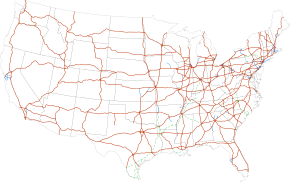Interstate Highway System facts for kids
  
Highway shields for Interstate 80, Business Loop Interstate 80, and the Eisenhower Interstate System
|
|

Interstate Highways in the 48 contiguous states. Alaska, Hawaii, and Puerto Rico also have Interstate Highways.
|
|
Quick facts for kids System information |
|
|---|---|
| Formed: | June 29, 1956 |
| Length: | 48,756 mi (78,465 km) |
| Highway names | |
| Interstates: | Interstate X (I-X) |
The Interstate Highway System is a huge network of freeways across the United States. Think of it as a giant system of super-highways! It was first planned by Dwight D. Eisenhower in the 1950s. He was the President at that time.
A special law, called the Federal Aid Highway Act of 1956, helped pay for building these roads. Most of the Interstates were built between the 1950s and the 1980s. However, new sections are still being added today. The entire system is now about 49,000 miles long. Some Interstates ask for a small fee, called a toll, to drive on them. But most of them are free to use. You'll also find rest areas every few dozen miles. These are great places to stop and take a break during long trips.
Contents
What Makes an Interstate Highway Special?
Interstate Highways are built in a very specific way to make driving safe and fast.
No Stoplights Allowed
One of the most important rules is that there are no stoplights on an Interstate. This means you can drive for a long time without stopping. To get on or off the freeway, you use a special road design called an interchange. These are like ramps and bridges that let cars smoothly join or leave the highway.
Speed and Lanes
The speed limit on Interstates is usually at least 55 miles per hour. This allows people to travel quickly. Each direction of traffic must have at least two lanes. These lanes are wide, at least 12 feet across, to give drivers plenty of space.
Separated Traffic
There is always a median or a barrier in the middle of an Interstate. This separates cars going in different directions. It helps prevent head-on crashes and makes the roads much safer.
How Interstates Get Their Numbers
The numbers on Interstate Highways tell you a lot about where they go.
Long-Distance Routes
Interstates that run north and south have odd numbers. These numbers get bigger as you go from west to east. For example, I-5 is on the West Coast, and I-95 is on the East Coast.
Interstates that run east and west have even numbers. These numbers get bigger as you go from south to north. For instance, I-10 is in the southern U.S., and I-90 is in the northern U.S.
One- or two-digit numbers are used for Interstates that travel very long distances across many states.
City Routes (Three-Digit Numbers)
Interstates with three-digit numbers are usually found in or around cities.
- Spur routes go into a city. Their numbers start with an odd digit.
- Loop routes go around a city. Their numbers start with an even digit.
For both spur and loop routes, the last two digits of their number are the same as the main Interstate they connect to. For example, I-280 might be a loop around a city, connecting to I-80.
See also
 In Spanish: Sistema Interestatal de Autopistas para niños
In Spanish: Sistema Interestatal de Autopistas para niños

